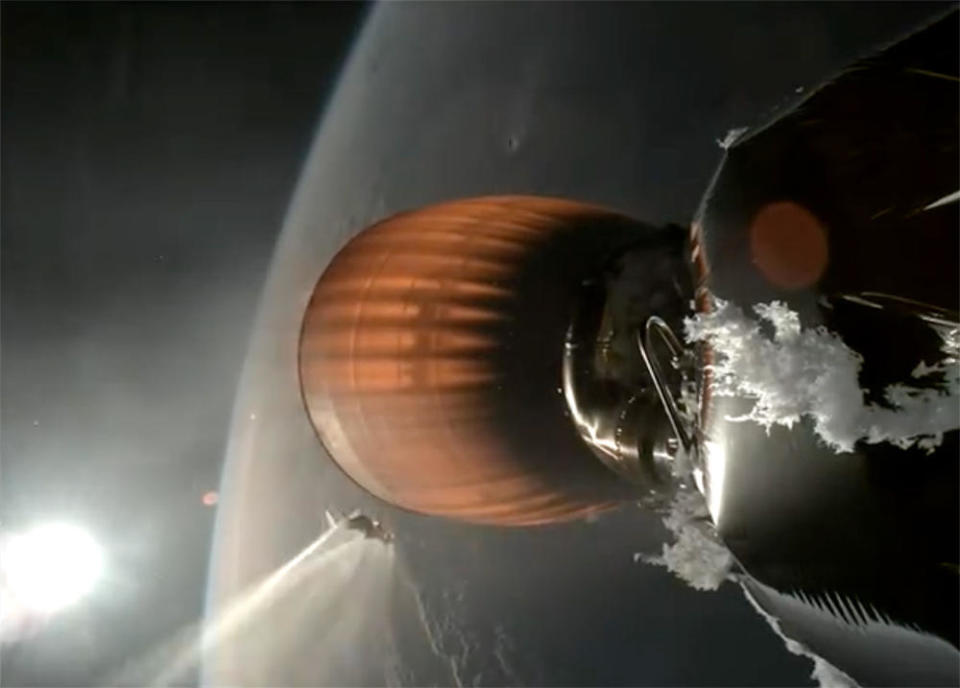The failure of the upper stage engine of a SpaceX rocket It was announced Thursday night that the Federal Aviation Administration will investigate the stranded 20 Starlink internet satellites in a low, unsurvivable orbit, likely delaying at least one and possibly two upcoming flights of the company’s Falcon 9 rockets.
The accident ended a remarkable streak of 344 successful flights by the Falcon 9 dating back to 2015. The FAA, which licenses commercial launches in the United States, said in a statement Friday that a joint investigation into the failure was needed before the workhorse Falcon 9 was allowed to fly again.

“A return to flight is based on a determination by the FAA that a system, process or procedure related to the accident does not impact public safety,” the FAA said. “In addition, SpaceX may need to apply for and receive approval from the FAA to amend its license to include corrective actions and meet all other licensing requirements.”
Meanwhile, the planned July 31 launch of entrepreneur Jared Isaacman and three crew members on a commercial flight that will include the first spacewalk by private citizens — Polaris Dawn — has been left in limbo.
The failure could also have implications for NASA’s plans to launch its next long-duration crew to the International Space Station. The Crew 9 mission is currently scheduled to launch around Aug. 19, but that assumes the investigation into the SpaceX failure is complete by then and NASA agrees with the findings.
Isaacman, however, was undeterred and posted a message on social media in which he and his crew, which included two SpaceX employees, indicated that they had complete confidence in the Falcon 9.
“SpaceX has an incredible track record with Falcon 9,” he said. “I can say from my own experience that they are very transparent when issues arise. I have no doubt that they will get to the root cause quickly and ensure that the most cost-effective and reliable launch vehicle continues to deliver payloads to orbit.
“As for Polaris Dawn, we will fly as soon as SpaceX is ready and with full confidence in the rocket, spacecraft and operations.”
Given SpaceX’s high flight speed and ability to launch its own payloads — Starlinks — the company may be able to recover in the relatively short term. But that depends on what went wrong, what it takes to fix it, and when the FAA issues a new launch license.
SpaceX founder Elon Musk thanked Isaacman for his support and said the company “will investigate the issue and look for other potential near misses. We plan to fly more Falcon flights this year than the shuttle has in 30 years, the vast majority of which will be unmanned.”
“A major advantage of this super-high flight speed is that we can identify and solve problems that only occur once every 1,000 flights. This is impossible with a vehicle with a low flight speed.”
Whatever the outcome, the incident underscores NASA’s ongoing push to certify Boeing’s Starliner capsule after it ongoing test flight is complete. The space agency wants two crew ships from different vendors to staff the International Space Station with NASA astronauts if a malfunction grounds one of the two.
Boeing has had its own problems with the Starliner, including a series of software and hardware issues that delayed its launch by four years. The spacecraft is currently docked with the space station, but the return to Earth of its first crewed test flight has been put on hold pending additional analyses of helium leaks and problems with its boosters.
Before Thursday’s launch, SpaceX had experienced just one failure in its 354 Falcon 9 and Falcon Heavy rocket launches since the system’s first flight in 2010.
A Falcon 9 carrying a Dragon cargo ship loaded with supplies and equipment for the International Space Station exploded during launch in June 2015, when an internal support failed and high-pressure helium ruptured the second stage’s liquid oxygen tank.
Musk wrote in a post on his social media platform Friday morning that the failed Starlink launch occurred during an attempt to restart the Merlin engine on the rocket’s second stage and place the spacecraft into the correct Starlink orbit.
He initially said the failure had resulted in “an engine RUD,” a tongue-in-cheek acronym that stands for “rapid unscheduled disassembly,” implying that the stage had either exploded or at least suffered a structural failure.
But the company later said the failure was due to a liquid oxygen fuel leak and that the stage survived the aborted engine start. But while it managed to deploy the Starlinks, they remained in an elliptical orbit with a nadir well below a manageable altitude.
“Following a planned restart of the upper stage engine to raise perigee — the lowest point of the orbit — the Merlin Vacuum engine experienced an anomaly and was unable to complete the second burn,” SpaceX said on its website.
“Although the stage survived and still deployed the satellites, it failed to circularize its orbit. This left the satellites in an eccentric orbit with a very low perigee of 135 kilometers (84 miles), which is less than half the expected perigee altitude.”
At that altitude, the satellites are pulled down during repeated passes through the extreme upper atmosphere. Even at full power, the thrust from the onboard ion engines “is unlikely to be enough to successfully bring the satellites up,” the company said.
“As such, the satellites will re-enter the Earth’s atmosphere and completely disintegrate (burn up). They pose no threat to other satellites in orbit or to public safety.”
President Biden to hold solo press conference after NATO summit | Special Report
SpaceX Falcon 9 breaks apart after launch, and more top stories
Biden tries to build support in Detroit amid growing calls to withdraw